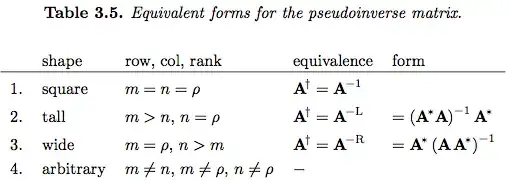Details in What forms does the Moore-Penrose inverse take under systems with full rank, full column rank, and full row rank?.
Summary
Given a matrix $\mathbf{A} \in \mathbb{C}^{m\times n}_{\rho}$ where $\rho\ge 1$, the singular value decomposition exists, and can be used to construct the pseudoinverse matrix $\mathbf{A}^{\dagger}$.

Block decomposition: general case
The block decompositions for the target matrix and the Moore-Penrose pseudoinverse are
$$
\begin{align}
\mathbf{A} &= \mathbf{U} \, \Sigma \, \mathbf{V}^{*}
=
% U
\left[ \begin{array}{cc}
\color{blue}{\mathbf{U}_{\mathcal{R}(\mathbf{A})}} & \color{red}{\mathbf{U}_{\mathcal{N}(\mathbf{A}^{*})}}
\end{array} \right]
% Sigma
\left[ \begin{array}{cc}
\mathbf{S} & \mathbf{0} \\
\mathbf{0} & \mathbf{0}
\end{array} \right]
% V
\left[ \begin{array}{l}
\color{blue}{\mathbf{V}_{\mathcal{R}(\mathbf{A}^{*})}^{*}} \\
\color{red}{\mathbf{V}_{\mathcal{N}(\mathbf{A})}^{*}}
\end{array} \right]
\\
%%
\mathbf{A}^{\dagger} &= \mathbf{V} \, \Sigma^{\dagger} \, \mathbf{U}^{*}
=
% U
\left[ \begin{array}{cc}
\color{blue}{\mathbf{V}_{\mathcal{R}(\mathbf{A}^{*})}} &
\color{red}{\mathbf{V}_{\mathcal{N}(\mathbf{A})}}
\end{array} \right]
% Sigma
\left[ \begin{array}{cc}
\mathbf{S}^{-1} & \mathbf{0} \\
\mathbf{0} & \mathbf{0}
\end{array} \right]
% V
\left[ \begin{array}{l}
\color{blue}{\mathbf{U}_{\mathcal{R}(\mathbf{A})}^{*}} \\
\color{red}{\mathbf{U}_{\mathcal{N}(\mathbf{A}^{*})}^{*}}
\end{array} \right]
\end{align}
$$
Blue entities live in range spaces, red in null spaces.
Sort the least squares solutions into special cases according to the null space structures.

Special cases
Square: Both null spaces are trivial: full row rank, full column rank
$$ m = n = \rho: \qquad \mathbf{A}^{\dagger} = \mathbf{A}^{-1}$$
Block structures:
$$
\begin{array}{ccccc}
\mathbf{A} &=
&\color{blue}{\mathbf{U_{\mathcal{R}}}}
&\mathbf{S}
&\color{blue}{\mathbf{V_{\mathcal{R}}^{*}}} \\
\mathbf{A}^{\dagger} &=
&\color{blue}{\mathbf{V_{\mathcal{R}}}}
&\mathbf{S}^{-1}
&\color{blue}{\mathbf{U_{\mathcal{R}}^{*}}}
\end{array}
$$
Verify the classic inverse:
$$\mathbf{A}^{\dagger}\mathbf{A} = \mathbf{A}\mathbf{A}^{\dagger} = \mathbf{I}_{n}$$
Tall: Only $\color{red}{\mathcal{N}_{\mathbf{A}}}$ is non trivial: full column rank
$$ m > n, n = \rho: \qquad \mathbf{A}^{\dagger} = \mathbf{A}^{-L}$$
Block structures:
$$
\begin{align}
%
\mathbf{A} & =
%
\left[ \begin{array}{cc}
\color{blue}{\mathbf{U_{\mathcal{R}}^{*}}} &
\color{red}{\mathbf{U_{\mathcal{N}}}}
\end{array} \right]
%
\left[ \begin{array}{c}
\mathbf{S} \\
\mathbf{0}
\end{array} \right]
%
\color{blue}{\mathbf{V_{\mathcal{R}}}}
\\
% Apinv
\mathbf{A}^{\dagger} & =
%
\color{blue}{\mathbf{V_{\mathcal{R}}}} \,
\left[ \begin{array}{cc}
\mathbf{S}^{-1} &
\mathbf{0}
\end{array} \right]
%
\left[ \begin{array}{c}
\color{blue}{\mathbf{U_{\mathcal{R}}^{*}}} \\
\color{red}{\mathbf{U_{\mathcal{N}}^{*}}}
\end{array} \right]
\end{align}
$$
Verify the left inverse:
$$\mathbf{A}^{\dagger}\mathbf{A} = \mathbf{A}^{-L}\mathbf{A} = \left( \mathbf{A}^{*}\mathbf{A} \right)^{-1} \mathbf{A}^{*}\mathbf{A} = \mathbf{I}_{m}$$
Wide: Only $\color{red}{\mathcal{N}_{\mathbf{A}^{*}}}$ is non trivial: full row rank
$$ m < n, m = \rho: \qquad \mathbf{A}^{\dagger} = \mathbf{A}^{-L}$$
Block structures:
$$
\begin{align}
%
\mathbf{A} & =
%
\color{blue}{\mathbf{U_{\mathcal{R}}}}
\,
\left[ \begin{array}{cc}
\mathbf{S} &
\mathbf{0}
\end{array} \right]
%
\left[ \begin{array}{c}
\color{blue}{\mathbf{V_{\mathcal{R}}^{*}}} \\
\color{red} {\mathbf{V_{\mathcal{N}}^{*}}}
\end{array} \right]
%
\\
% Apinv
\mathbf{A}^{\dagger} & =
%
\left[ \begin{array}{cc}
\color{blue}{\mathbf{V_{\mathcal{R}}}} &
\color{red} {\mathbf{V_{\mathcal{N}}}}
\end{array} \right]
\left[ \begin{array}{c}
\mathbf{S}^{-1} \\
\mathbf{0}
\end{array} \right]
%
\color{blue}{\mathbf{U_{\mathcal{R}}^{*}}}
%
\end{align}
$$
Verify the right inverse:
$$\mathbf{A}\mathbf{A}^{\dagger} =
\mathbf{A}\mathbf{A}^{-R} =
\mathbf{A}\mathbf{A}^{*} \left( \mathbf{A} \, \mathbf{A}^{*} \right)^{-1} = \mathbf{I}_{n}$$


– Naryxus May 13 '19 at 18:05I get the intuition why the mapping from $\mathbb{R}^3$ to $\mathbb{R}^2$ cannot be injective (consider a projection on a plane etc.). But I have no idea how the formal proof of this looks like, because we have two infinite sets, so there could possibly be an unique element in $\mathbb{R}^2$ for each element in $\mathbb{R}^3$.
I don't understand the step from the non-injectivity to the non existence of the left pseudoinverse.